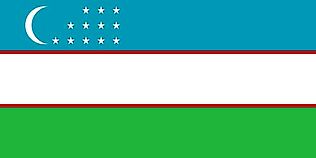About Republic of the Uzbekistan

History
Before the X century A.D. the territory of Uzbekistan was populated mostly Iranian nomads, as evidenced by archeological finds of tools of labor and monuments in Ferghana, Tashkent, Khorezm, Samarkand and Bukhara. The first states that emerged on the territory of modern Uzbekistan were Sogdiana and Khorezm. Alexander the Great conquered Sogdiana and Bactria in 327 BC, marrying Roxana, daughter of a local Bactrian chieftain. The conquest was supposedly of little help to Alexander as popular resistance was fierce, causing Alexander's army to be bogged down in the region.
For many centuries the region of Uzbekistan was ruled by Persian empires, including the Parthian and Sassanid Empires.
In the XIV century began his reign of Tamerlane (1336—1405). He imbued his empire with a very rich culture. During Tamerlane's reign and the reigns of his immediate descendants, a wide range of religious and palatial construction projects were undertaken in Samarqand and other population centres. Tamerlane also initiated exchange of medical thoughts and patronized physicians, scientists and artists from the neighboring countries like India.
Tamerlane built the imperial capital in Samarkand. Today he is regarded as one of the greatest heroes in Uzbekistan.
In the nineteenth century, the Russian Empire began to expand and spread into Central Asia. By the beginning of the twentieth century, Central Asia was firmly in the hands of Russia, and despite some early resistance to Bolsheviks, Uzbekistan and the rest of Central Asia became a part of the Soviet Union. Uzbekistan functioned as a territorial entity within the USSR until the last decade of the XXth century.
On the 31 August 1991 was adopted Declaration of Independence, thus Uzbekistan became an independent and sovereign State. Independence day is celebrated on September 1.
Geography
The Republic of Uzbekistan is located in the Central and North-Western parts of Central Asia, stretching from North-West, from the shores of the Aral Sea, South-East towards the river valley Syrkhandarya. The capital of Uzbekistan is Tashkent.
Bordering Kazakhstan and the Aral Sea to the north and north-west, Turkmenistan to the south-west, Tajikistan to the southeast, and Kyrgyzstan to the northeast. Uzbekistan also shares a short border (less than 150 km) with Afghanistan to the south.
The total length of the boundaries is 6621 km. The most northerly point – is in the North-East plateau Usturt (45°36’ N), the most sourtherly point – Termez (37° 13′ N), the most westerly point is plateau Usturt (56° E) and the most easterly point – is in the South-East of Fergana valley (73°10° E). Uzbekistan occupies an area of 447000 km2.
Uzbekistan is one of two doubly landlocked countries in the world, i.e., a country completely surrounded by landlocked countries – the other being Liechtenstein. Less than 10% of its territory is intensively cultivated irrigated land in river valleys and oases. The rest is vast desert (Kyzyl Kum) and mountains.
The climate in the Republic of Uzbekistan is continental, with little precipitation expected annually (100–200 millimeters). The average summer high temperature tends to be 40 °C (104 °F), while the average winter low temperature is around −23 °C (−9 °F).





